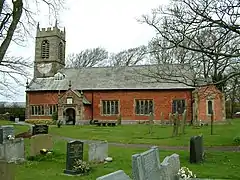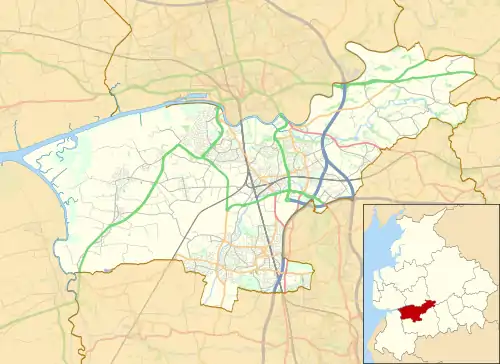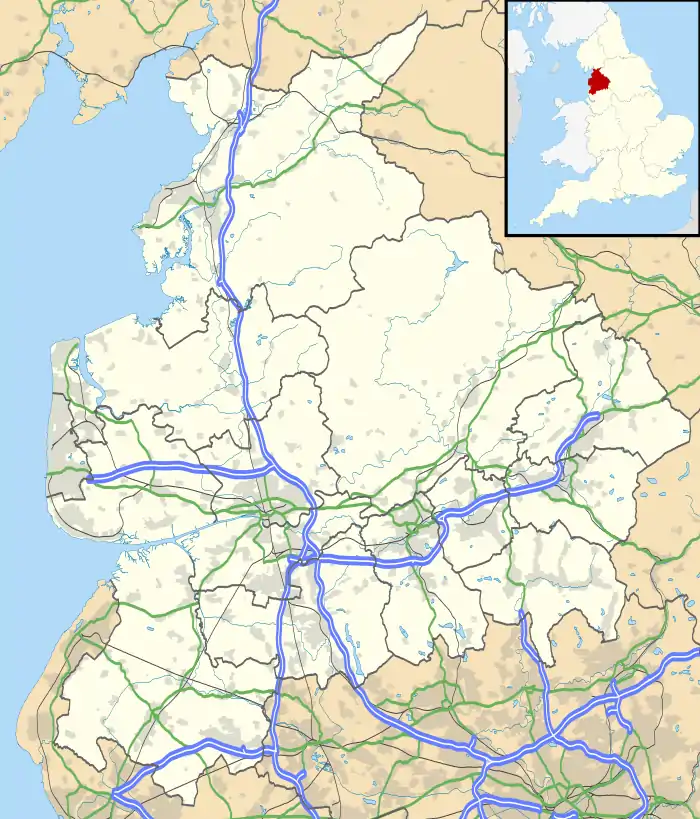Much Hoole
Much Hoole is a village and civil parish in the borough of South Ribble, Lancashire, England. The parish of Much Hoole had a population of 1,851 at the time of the 2001 census, increasing to 1,997 at the 2011 Census.[2]
| Much Hoole | |
|---|---|
 St Michael's Parish Church | |
 Much Hoole Shown within South Ribble  Much Hoole Location within Lancashire | |
| Population | 1,851 [1] |
| OS grid reference | SD471232 |
| Civil parish |
|
| District | |
| Shire county | |
| Region | |
| Country | England |
| Sovereign state | United Kingdom |
| Post town | PRESTON |
| Postcode district | PR4 |
| Dialling code | 01772 |
| Police | Lancashire |
| Fire | Lancashire |
| Ambulance | North West |
| UK Parliament | |
History
Hoole derives from the Old English hulu, a shed or hovel. It was recorded as Hull in 1204, Hole in 1212 and Hoole in 1508. Magna Hole was recorded in 1235, Much Hole in 1260[3] and Grett Wholle in 1551.[4]
At Much Hoole there are the remains of a medieval settlement and moat adjacent to Town Lane. Hoole gave its name to a family in the reign of King John and the parish has been held by the Montebegon family and by others, including those of Sir Thomas Hesketh and George Anthony Legh Keck.
Governance
The township was separated from Croston in 1642, and made into a parish in the Leyland hundred of Lancashire.[5] It became part of the Preston Poor Law Union, formed in 1837, which took responsibility for the administration and funding of the Poor Law and built a workhouse in the area.[6]
The parish was part of Preston Rural District throughout its existence from 1894 to 1974.[7] In 1974 the parish became part of South Ribble.
Religion
A chapel is mentioned in a grant of about 1280 by Amery de Hoole but it is not known what happened to it.[4] St Michael's Church was built of brick in 1628 and a stone tower was added when it was rebuilt in 1720.[5] The church was funded by the Stone family who lived at Carr House. Jeremiah Horrocks, who predicted the transit of Venus in 1639, was a curate at St Michael's. He is commemorated in some of the church's windows.[8]
Geography
Much Hoole lies eight miles south west of Preston on the A59 from Preston to Ormskirk and Liverpool. It covers 1,701 acres (688 ha) of flat low-lying land. The soil is loam, peat moss and marsh.[5][9] The River Douglas, which leads to the Ribble Estuary, forms Much Hoole's western boundary. Carr Brook forms its southern boundary. The highest land reaches 70 feet (21 m) above sea level in the east along the boundary with Leyland. The Preston to Southport line (closed in 1964), built by the Lancashire and Yorkshire Railway, crosses the north-west corner of the township.[4]
Population
| Population growth in Much Hoole from 1881–1961 | |||||||||||
|---|---|---|---|---|---|---|---|---|---|---|---|
| Year | 1881 | 1891 | 1901 | 1911 | 1921 | 1931 | 1951 | 1961 | |||
| Population | 581 | 567 | 624 | 627 | 613 | 621 | 716 | 745 | |||
|
Much Hoole CP/Tn[10] | |||||||||||
Transport
The A59 (Liverpool Road) runs through part of Much Hoole but mainly by-passes the village to the west. The village has regular bus services linking it with Preston, Southport and other local villages. Main roads in the village include the former main road, Liverpool Old Road, which passes through the centre of the village and Town Lane, which merges into Smithy Lane.
Much Hoole and Little Hoole were served by Hoole railway station on the West Lancashire Railway until the line closed in 1964.
In December 2005, plans for a 'microlight farm airstrip' between Bretherton and Much Hoole were rejected by Chorley and South Ribble councillors due to the fear of sound pollution and damage to the surrounding environment.
Facilities
There are two public houses, the Smithy Inn and the Fox Cub. The Rose and Crown, once owned by Albert Pierrepoint the Chief Executioner[11] and the Black Horse pub have been converted to restaurants.
The village primary school is Hoole St. Michael's. The village has a village hall, a park, tennis courts, and a bowling green. In 2006 the Little Chef was converted into an ice cream parlour and tapas bar. Nearby property has been redeveloped into a small shopping and business park. There are new housing developments in the village.
Gallery
 Fields around Much Hoole
Fields around Much Hoole Public footpath near acres of greenhouses
Public footpath near acres of greenhouses Long Fold Farm, Much Hoole
Long Fold Farm, Much Hoole Pylons from Much Hoole to Bretherton
Pylons from Much Hoole to Bretherton
See also
References
- "2001 Census: Key Statistics: Parish Headcounts: Area: Much Hoole CP (Parish)". Office for National Statistics. Retrieved 26 August 2008.
- "Civil Parish population 2011". Retrieved 18 January 2016.
- Mills 1976, p. 97
- Farrer, William; Brownbill, J, eds. (1911), "Townships:Much Hoole", A History of the County of Lancaster: Volume 6, British History Online, pp. 149–153, retrieved 1 October 2011
- Lewis, Samuel (1848), "Hoole(Holy Trinity)", A Topographical Dictionary of England, British History Online, pp. 542–545, retrieved 4 June 2010
- Workhouse, Workhouses.org, retrieved 1 October 2011
- Preston RD, Vision of Britain, accessed 9 June 2014
- "Archived copy". Archived from the original on 26 August 2002. Retrieved 28 February 2010.CS1 maint: archived copy as title (link)
- Much Hoole Township Boundaries, GenUKI, retrieved 1 December 2010
- Much Hoole Ch/CP : Total Population, Vision of Britain, retrieved 1 December 2010
- "Albert Pierrepoint, 87, Hangman In Hundreds of British Executions". The New York Times. 13 July 1992. Retrieved 26 August 2008.
Bibliography
- Mills, David (1976), The Placenames of Lancashire, Batsford, ISBN 0-7134-5236-6
External links
| Wikimedia Commons has media related to Much Hoole. |